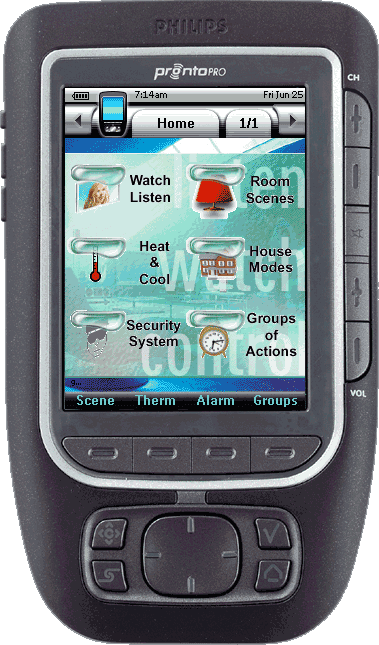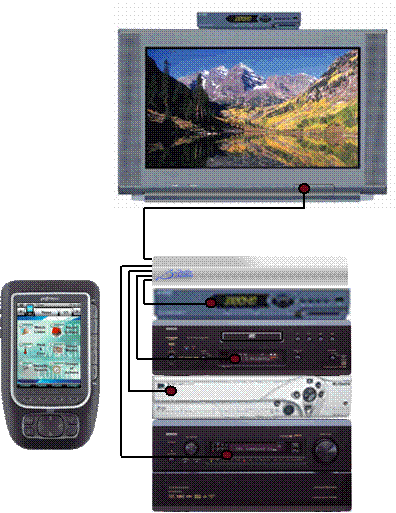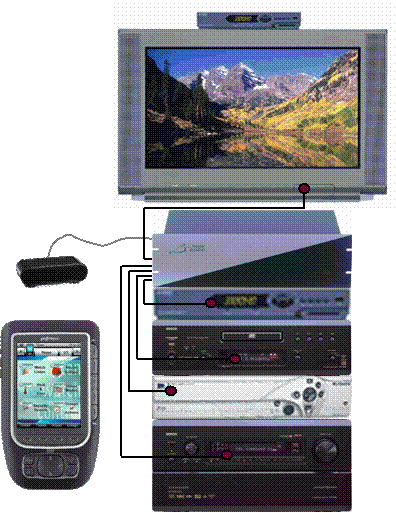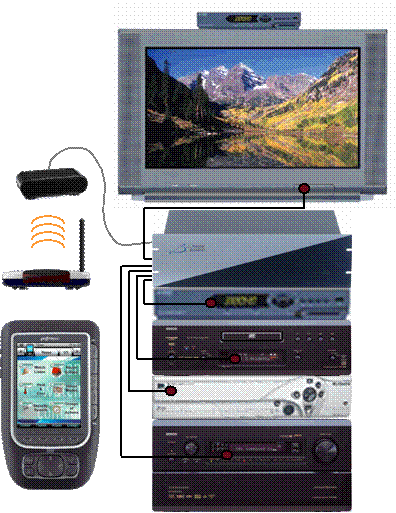Download the Pronto Application we Wrote
for you
We wrote an application for the Philips Pronto
TSU-7000 that you can download and start using immediately. The path is
shown at the right.
Download the application:
Pronto
sending RF code 83.pcf
to your desktop so that you can load it into
the Pronto Pro editor below.
|
Click here
to go to our web site for the Pronto
http://www.destinynetworks.com/
Downloads/
Password_Protected/
Software for 3rd Party
Products/
Philips Pronto/
|
Load
the example program
Install and run the Pronto Editor Pro program
that came with the TSU-7000 product.
When it first opens, it will ask what file
you would like to work with. Select "Open an existing configuration
file" and click on "More Files ...".
Click OK.
|
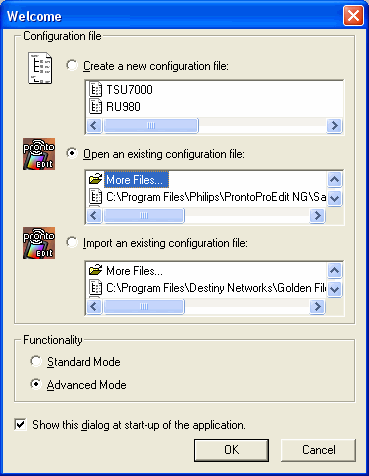
|
|
The "Open" menu will pop up.
Navigate up to where you save the file you
downloaded from our web site, select it, and click "Open".
|
|
|
You will get a Pronto project with the 3 active
devices: "System", "Home", and "RC-1 Extended".
there will also be 2 hidden devices: "[Ubq IR]", the IR codes
that the Domain Controller recognizes, and "[]" which has some
background pages in it.
|
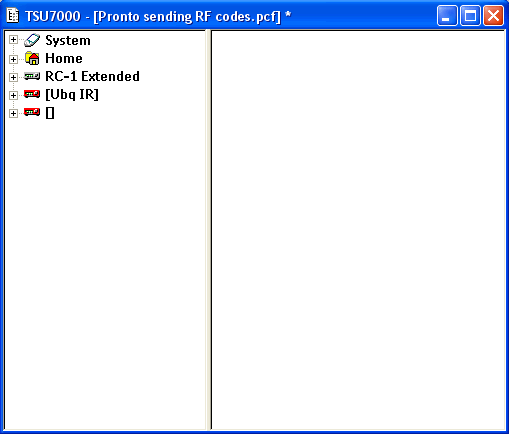
|
|
Open the Home page. It provides access to
control AV entertainment, Room scenes, Heating and cooling, House modes,
the Security system, and Groups of Actions.
The "Home" hard button on the bottom
right of the remote control will return you to this page.
|
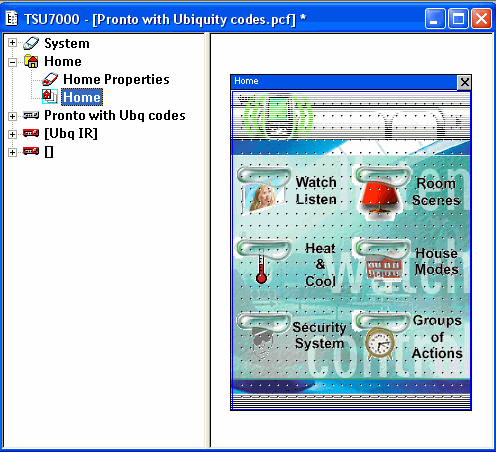
|
AV Sources
Open up the "AV Sources nice icons"
page of the "RC-1 Extended" device.
Seven AV sources have been set up for you
("TV/Video", on the bottom right, is not a source - it toggles
the TV through its input connector groups).
If your theater uses any subset of these sources
and does not have two or more of the same type of source, then no
programming is necessary - the Domain Controller can receive the
commands that are already loaded into the Pronto and translate them to
control the actual equipment that exists in your theater.
With the actual Pronto remote control, selecting
the desired source will send out a short command from the remote control
requesting that the Domain Controller set up the path for playing the
selected device. The Domain Controller will do the rest. It will set up
the whole path from the chosen source to the display and/or speakers.
The Pronto will then jump to the transport page for controlling the theater.
If the source is already playing, then the
user can
select "Favorites" or "Transport" at the bottom of
the page. Each will jump to a new page.
The user can get to the AV Sources page by:
|
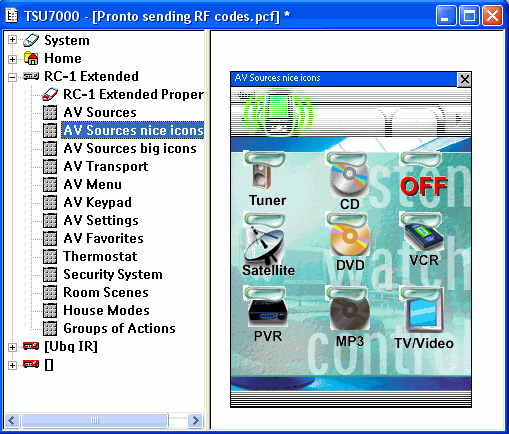
|
Favorites
With the actual Pronto remote control, the
user can get to the Favorites page by:
In the ProntoEdit NG program, open the AV
favorites page. There are only a couple
of favorites on the page.
To create a new favorite, "Ctrl click"
on an existing one and drag it to the new location.
|
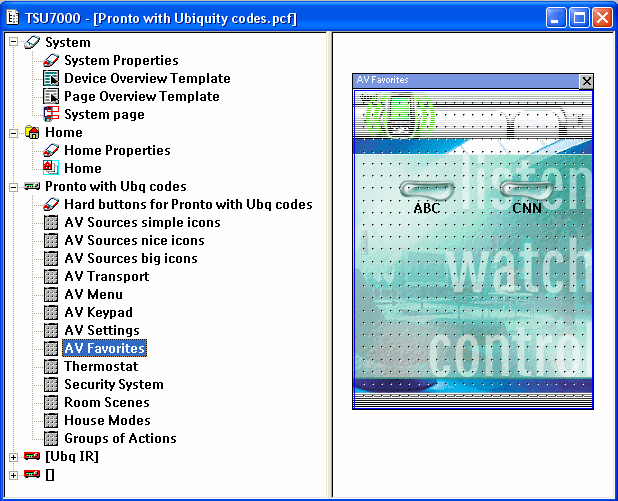
|
|
Double click on the icon of the favorite to
open the "Button Properties" page. Note that pressing the "ABC"
button will send the commands "3", "8", "3",
"Enter" to the active source. Delays between codes are not needed
as the Domain Controller already knows how to control the AV components.
To create your own Pronto macro:
|
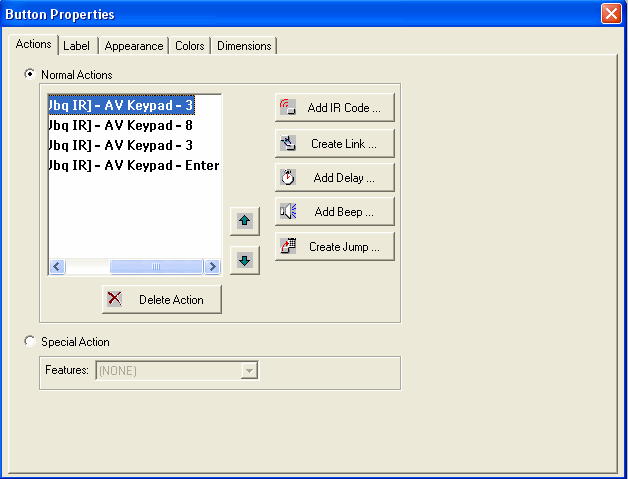
|
|
You will get the "Create Link" pop
up menu at the right.
Open the "[Ubq
IR]" hidden device. This is the ccf file of IR codes that the Domain
Controllers recognize. Scroll down and open
the "AV Keypad" page. Double click on the
first digit of the channel number to send. Repeat for the other
digits of the channel number. Add "Enter"
if appropriate.
That's all you need to do. Save the file and
download it to the Pronto. |
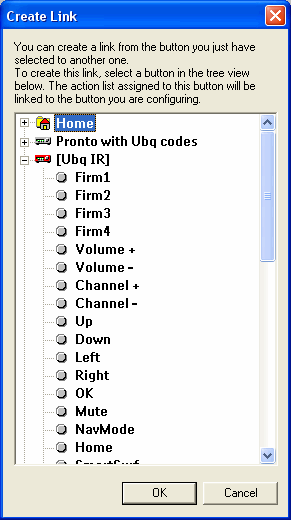 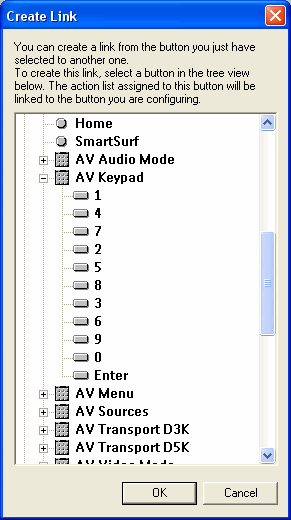
|
Heating and
Cooling
The Thermostat page allows the user to control
the temperature in the room by setting the mode and/or target temperature
in the room. This requires that the room has an intelligent thermostat.
The buttons on the right enable direct setting of the temperature in the
room.
You can get to the Thermostat page by:
|
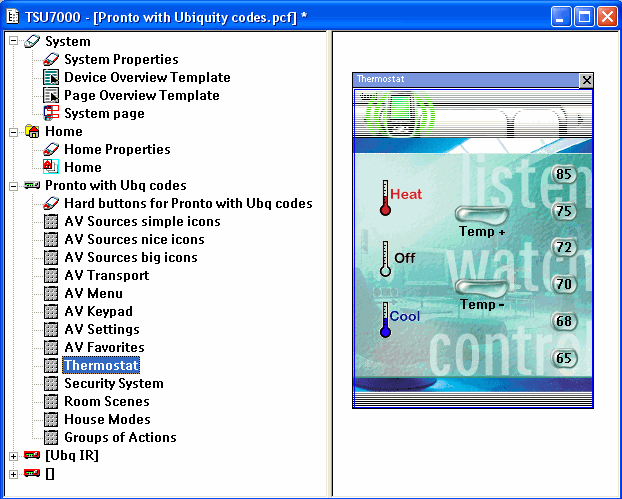
|
Security System
The Security System page allows the user to
arm and disarm the security system from the theater room. This requires
that the house has an intelligent security system.
You can get to the Security System page by:
|
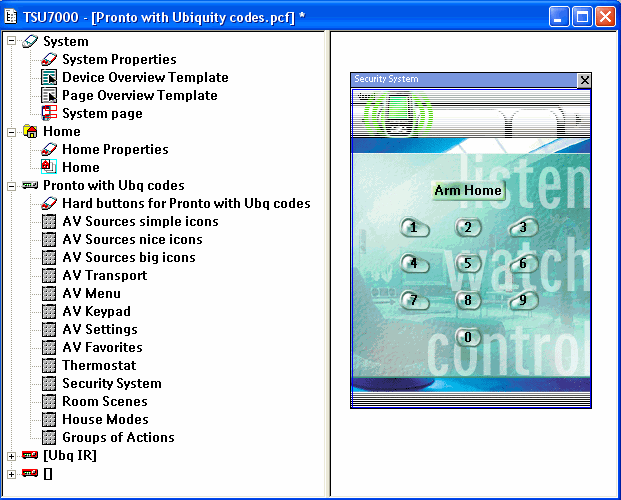
|
Room Scenes
The Room Scenes page allows the user to control
the lights, fans, curtains, and other devices in the room from the remote
control. This requires that the house has an intelligent lighting system.
In addition to changing multiple devices in
the room via the Room scene, this page gives direct control of a smaller
set of devices.
You can get to the Room Scenes page by:
|
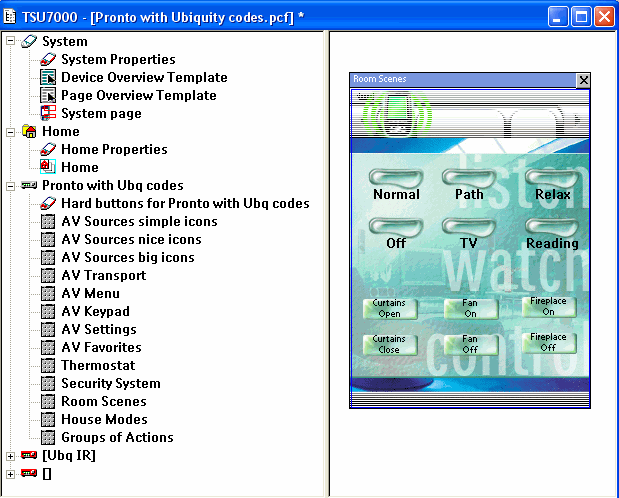
|
|
|
|
Groups of Actions
The Groups of Actions page allows the user
to execute the default set of Groups of Actions from the remote control.
You can get to the Groups of Actions page
by:
Note, you must set up these Groups of Actions
in the home, and they must have the same names as the ones on the Add
a Remote menu with question marks around them. For example, the button
"??Outdoor Lights On??" is looking for the Group of Actions
"Outdoor Lights On". |
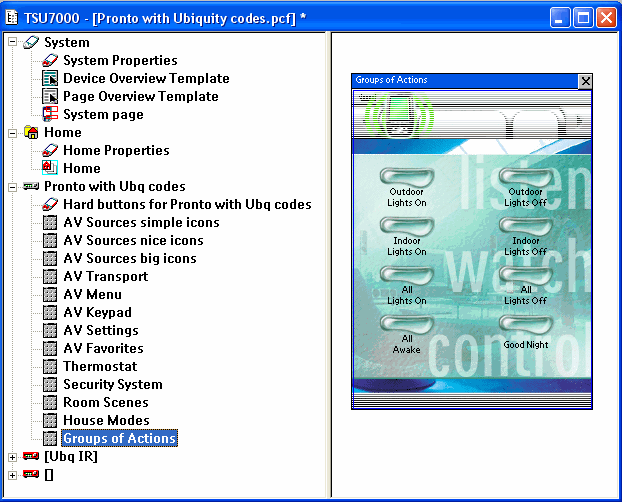
|
Configure
Ubiquity
If the theater has a second source of the
same type, you will have more work to do, but if the activities above
complete the programming of the Pronto, then you are ready to configure
Ubiquity and it will be simple, also.
Go to the AV Remote Control layer of the Design
Module.
|
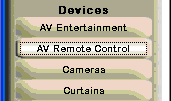
|
|
Click in the room in which the TV and/or Speakers
that you want to control is located (it does not matter where the sources
are located).
|
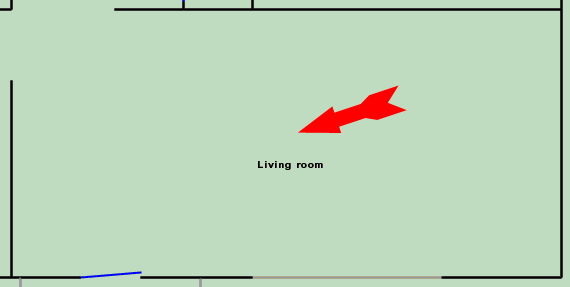
|
Add a Remote
You will get the Add a Remote pop-up menu
shown below.
Select a "Location" if you like.
It is just an auto naming feature.
Change the "Name" if you like, but
the default will work unless there is already another remote by the same
name in this room.
The only "Make" that is available
is Destiny because we will be using the Destiny IR codes.
For "Model" select "Any Remote
using Ubiquity ccf addr 83".
At the bottom of the page, make sure "Controlled
by (and wire to)" is checked.
For the Domain 3000, select the RF to IR (Digital
input 2).
For the address, enter
83. The default set of IR codes that are in the file "Any
Remote using Ubiquity ccf addr 83" is address 83. If you are using
the Sports Bar application, you will see that other code sets are available.
The buttons in the middle of the menu represent
the buttons of the remote control, meaning that the IR code that gets
sent by the remote control is a number that is an index into this menu.
Then, each button uses the Action Tree to determine what to do - as illistrated
by the names on the buttons below. You do not need to know any of this
unless you have two sources of the same type (e.g., two DVD players),
or you want to control HVAC or security systems.
Click OK (you may have to resize the windows
task bar at the bottom of your display to get to the OK button).
You are done. Hook up the wires and use Check
My Destiny to check your work.
|
|
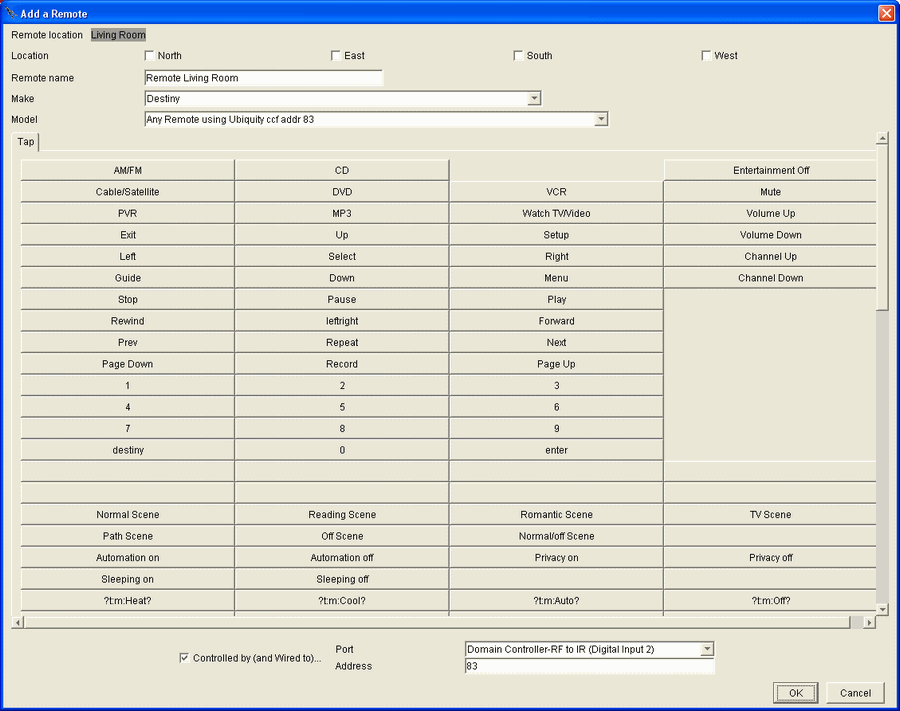
Note that this software
releases requires that the actual name of the HVAC zone and Security System
be configured into the menu. For those buttons that have question
marks ("?") at the beginning and end of the name, click on them
and use the Action Tree to select the appropriate command. Refer to UAPI Specification for RS-232 to figure
out the command that should be on each button. For example, the name "?t:m:Heat\n?
can be found in the UAPI specification to mean "Set the thermostat
to heating mode". Therefore, you would click on this button and use
the Action Tree to set the thermostat in the zone in which the remote
control is located to heating mode. Note that if you are not using this
remote control to control HVAC or security, then you do not need to do
this step.
|
Add
a Second Source of the Same Type
Adding a second source of the same type (e.g.,
a second DVD player) is pretty easy. There are just 2 steps.
Program the Pronto to
send out a unique IR code to play the 2nd DVD player in the Living room. Take the IR code that
was just programmed into the Pronto and map it to Play the 2nd
DVD player in the Living room in the Domain Controller software.
In Pronto Edit Pro, open the "AV Sources
nice icons" page. |

|
|
First, let's see how the existing source buttons
work.
In the example at the right, we selected the
DVD icon.
When the button is pressed, first it sends
a command to the Domain Controller so that the Domain Controller will
set up the path for that source to play on the TV and/or speakers in the
room. Then, the button causes the Pronto to jump
to the Transport page (you can only see the first part of the destination
of the jump in the example at the right) so that the component can be
controlled by the user.
|
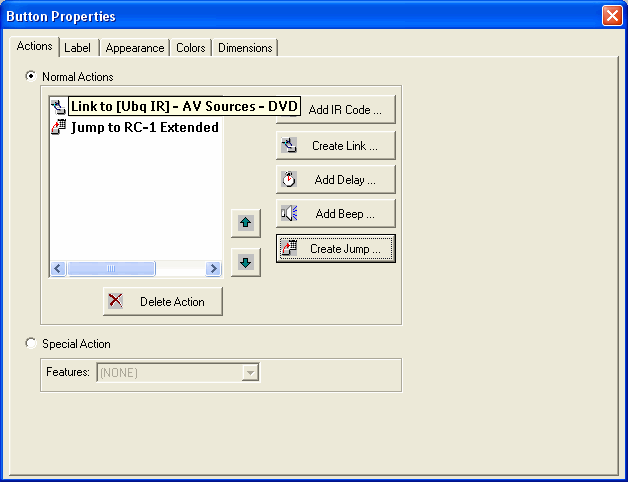
|
|
Therefore, to control an additional AV source,
start by duplicating one of the existing AV sources
on the AV sources page.
In our example, we will duplicate the DVD
player.
Next, click the "Appearance" tab
at the top of the Button Properties menu. Note
that the word "DVD" is part of the bitmap of the button image.
Using the Label, you can add the 2 to the image or create a new image
that looks a little better.
Important: The IR code that the Pronto will
send is the IR code of the device you copied. That IR code is a reference
into a table of actions. That table is the set of button on the Remote
Control menu of the Design Module (the menu that looks like a field of
buttons).
Recall that the Pronto is sending out Destiny
IR codes (which are then modulated onto a radio frequency (RF) to be transmitted
through the air). Each code is unique and it is mapped to one of the buttons
on the Ubiquity AV Remote Control menu (the one that looks like a "field
of buttons"). Essentially, the IR code that is sent out is directly
mapped to one of those buttons. And, you get to choose what that IR code
does by clicking on the button on the AV Remote Control menu and using
the Action Tree to select an action.
|
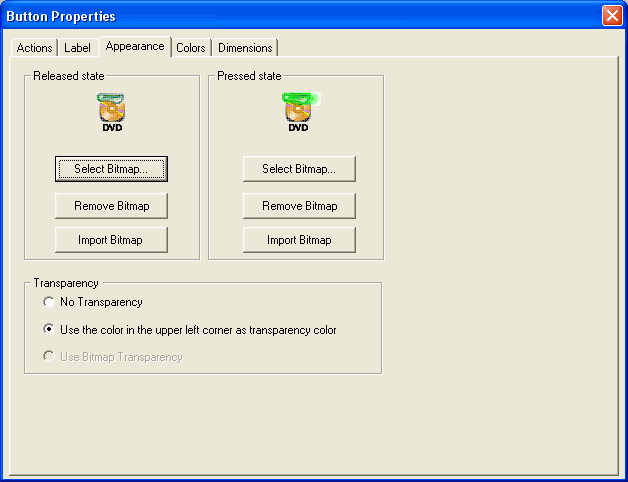
Summarizing the chain of events:
[Press DVD 2 button on the Pronto] ->
[Sends Unique Destiny IR code (modulated on RF)] ->
[Mapped to a button on the Remote Control
menu] ->
[Plays DVD2 in the Living room] |
|
Therefore, we want the new button to send
out an IR code that maps to an unused button in the Ubiquity AV Remote
Control menu.
Delete the existing link.
Click "Create Link...".
Open "[Ubq]" (the hidden one, not
"RC-1 Extended" - the active one).
Scroll down and open the "User 40, 41"
page. The User IR commands are IR commands that have been reserved for
applications like a second AV component of the same type.
Select the "User 40-1" IR code.
The number refers to the 40th row, 1st column of the Ubiquity AV Remote
Control menu (which is where we will put the Action to play the 2nd DVD
player).
Click OK.
Re-order the actions so that the "Jump"
occurs last.
Click the "X" in the upper right
to close the box (it will keep your changes).
You are done setting up the Pronto.
Save the changes and download the program
to the Pronto.
|
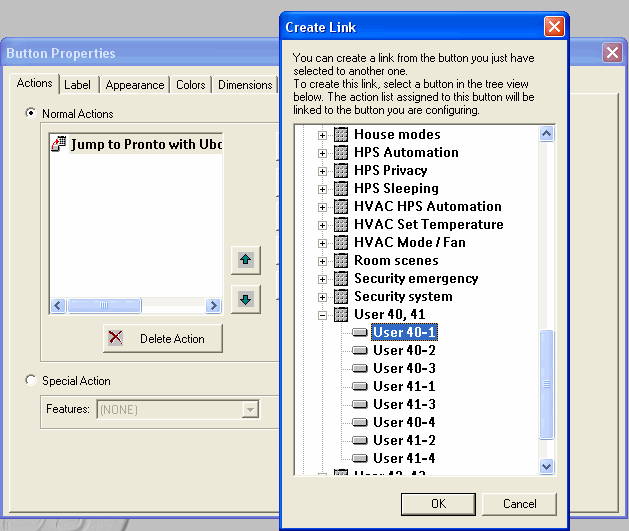
|
|
|
|
Add buttons to the representation of the
remote control on the AV Remote Control layer to play each DVD player
First, go to the AV Entertainment layer and
click in the appropriate rooms to get the "Schematic" menu.
Look at the name of the 2nd AV component ("Living
room DVD 2" in the example at the right).
Close the menu by clicking "Done".
|
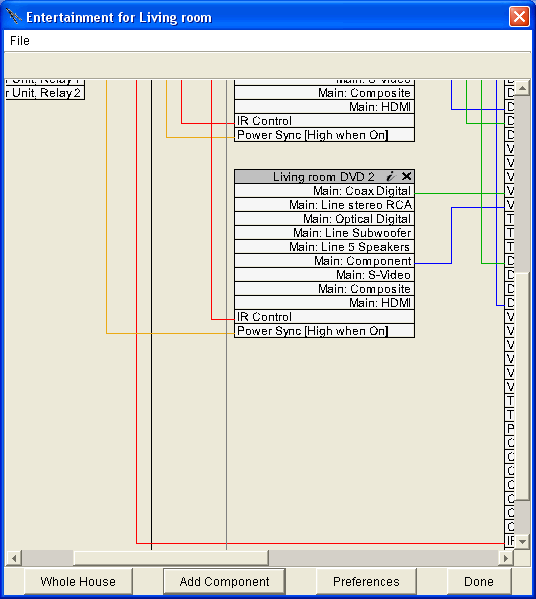
|
|
Now, go the AV Remote Control layer of the
Design Module.
Click on the dot representing the existing
Pronto remote control (if you have not added one yet please do so by referring
to Configure Ubiquity)
|

|
|
You will get the Edit Remote menu.
Scroll all the way down to the bottom of the
menu using the scroll bar on the right of the menu.
You will get the menu shown at the right (but
easier to see).
Note that one of the buttons on the bottom
left is labeled "?User 40-1?". When the DVD 2 button is pushed
on the Pronto, an IR code will be sent to the Domain Controller that will
invoke the action on this button. We will now change this button to play
the DVD 2 player.
|
|
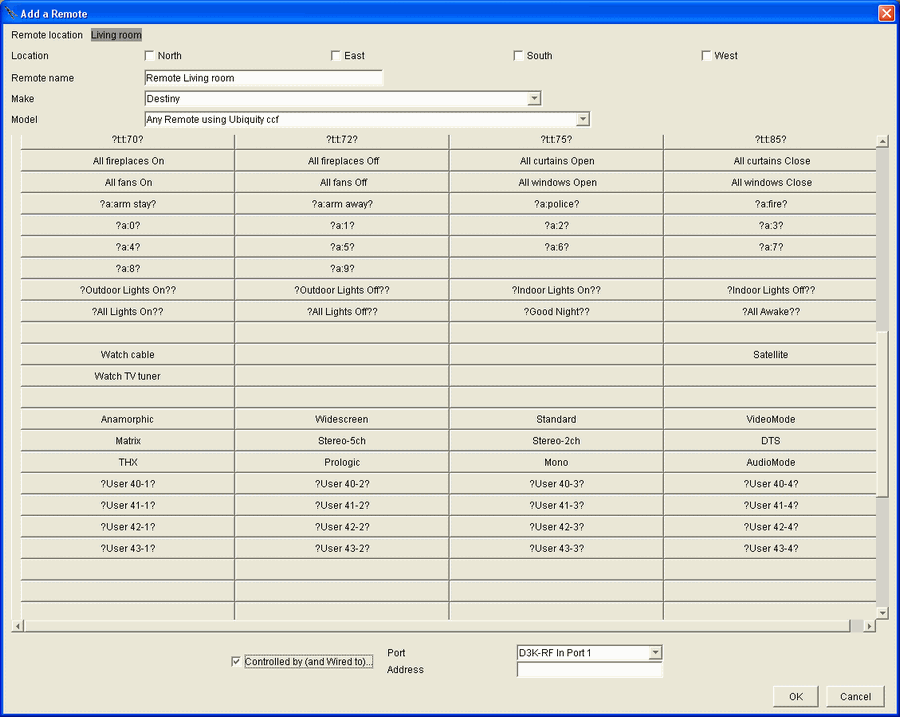
|
|
Click on the User 40-1 button (as shown below)
to bring up the action tree. Follow the path shown to play the DVD 2 player.
Note that you cannot use "This Room"
because relative addressing for AV components requires that only one source
of each type can be available in a room.
|
|
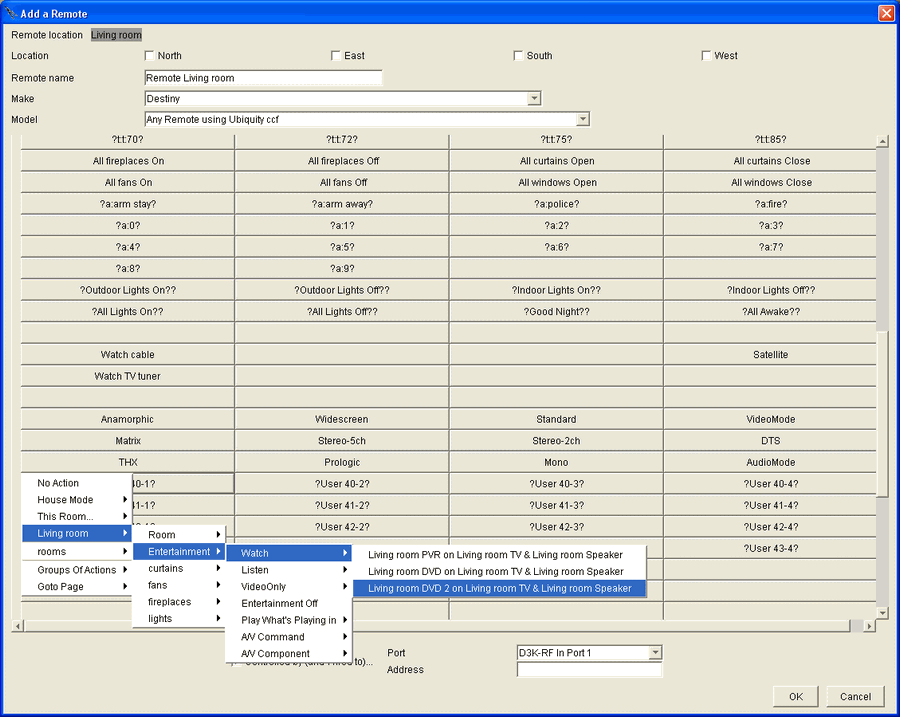
|
|
You should also click on the existing "DVD"
button and give it an absolute path to the 1st DVD player. This way, if
you rearrange DVD players in the Ubiquity menus, good things will still
happen.
You are done.
|
|
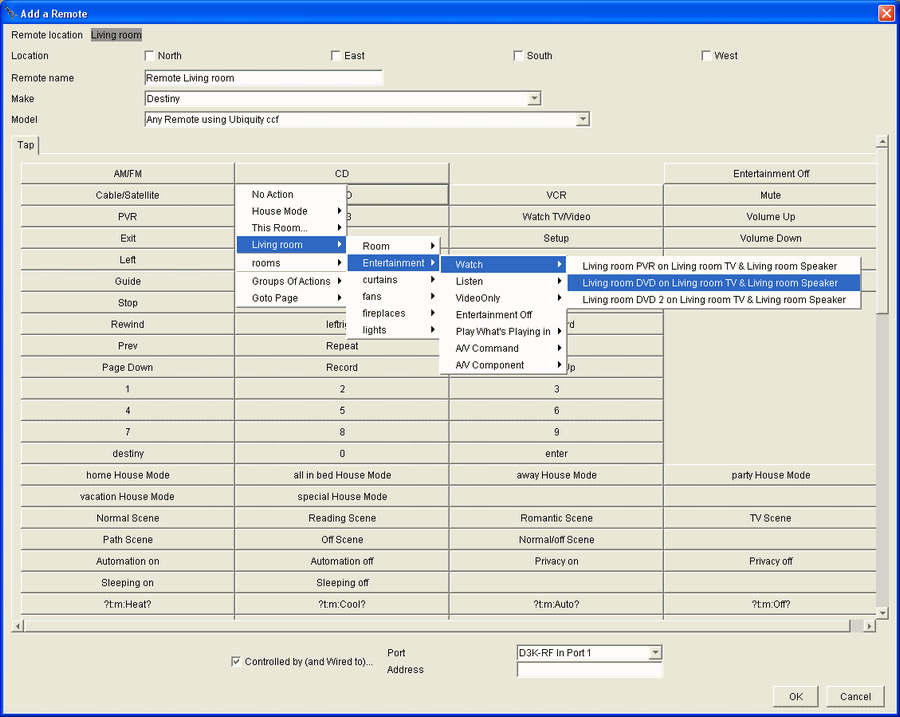
|
|
|
|
|
|
|
|
|
|
|
|
|
|
|
|
|
|
|
|
|
|
|
|
|
|
|
|
